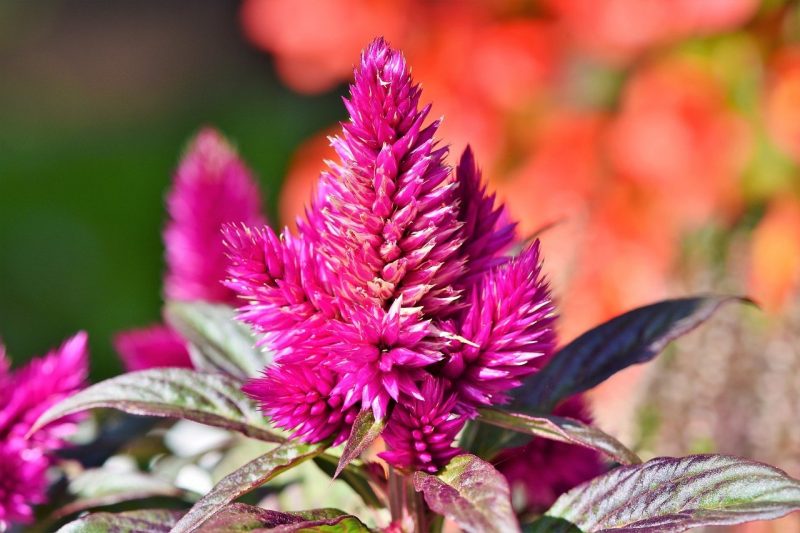You can learn how to grow celosia from seed in two easy steps. You can feel confident in starting these gorgeous annuals because they are relatively easy to grow even from seeds. Remember that gardeners do not often entertain the idea of starting plants from seeds because it’s a tad meticulous compared to other propagation methods.
While it’s true that celosia won’t give you a hard time when you start it from seeds, you can also consider growing in the greenhouse. The greenhouse is an excellent environment for starting plants, especially from seeds, because you can control the internal conditions. The stable and controlled factors indoors will guarantee germination and establishment.

How To Grow Celosia From Seed For Beginners
Step #1. Sowing
The only propagation method for celosias is from seed. You might be intimidated by how fine these seeds are, but you shouldn’t face any problem in germinating them. When should you sow celosia seeds?
Indoor or outdoor planting
You have the option to sow celosia directly on the ground outdoors as long as the last frost has passed. However, it’s more advantageous to grow them in the greenhouse six weeks before the average last frost day. Gardeners opt for starting indoors because the plant will be larger and have better flower spikes.
Germination requirements
The main reason why timing is vital for sowing celosia seeds is that the soil must be warm enough to encourage germination. Therefore, you can only sow directly in the garden during spring. Otherwise, you can sow early in the season using the greenhouse.
Besides warm soil, another germination requirement of celosia seeds is moisture. You must cover the seeds lightly with fine soil after sowing them at the surface, and then keep the soil moist. Gardeners often use peat pots with a moist seed-starting mix, so you don’t have to transplant since peat pots decompose.
The greenhouse will also provide the ideal conditions for germination. For example, you can place them somewhere that will receive light but not direct sunlight. Place the pots at 70 to 80°F, and this should also encourage sprouting within 10 to 15 days.
Step #2. Maintenance
Seedling care
As mentioned earlier, moisture is essential to encourage the development of celosia seeds. However, you must also take into consideration the conditions that will promote the healthy growth of seedlings. For example, indoor temperatures between 63 to 68°F is optimal for celosia seedlings to develop.
You can also use grow lights starting at a distance of 6 inches above them at around 12 hours a day. Compared to direct sunlight, the control of lights in the greenhouse does not put the seedlings at risk for burning. Over time, you can thin the seedlings so that there is only one per pot using small pruners, and pinch the center stem’s tip once the plant is 8 inches tall.
Transplanting
Thinning the seedlings and pinching the center stem will help anticipate the plants’ growth and encourage branching. You will also be close to transplanting the celosia plants once you notice true leaves. However, it’s worth emphasizing the importance of hardening the celosias first for at least ten days before transplanting them outdoors.
Gradually expose the plants outside to the sunlight for a few hours to prevent the risk of transplant shock. Once the temperatures at night are around 55°F, you can move the plants outdoors permanently. You can plant the peat pots directly, but make sure that there is no exposed top portion that will wick the moisture away.
Growing celosia outdoors
Being a tender annual, you can expect that celosias will thrive in full sun. You can also amend the ground to improve its water retention and drainage and improve its fertility. Make sure to check the celosia variety; you have to anticipate the space they require as well.
The maintenance practices for celosia plants is simple. Much like with other plants, you want to keep them hydrated. You can also fertilize once a month to keep them healthy and blooming well in summer or fall.
Speaking of which, don’t forget to pinch your plants’ first plumes to encourage growth later on. As time goes on, be on the lookout for pests such as aphids and immediately address them with organic insecticides. You must also ensure that you’re not overwatering to prevent fungal diseases.
Conclusion
Propagation can be intimidating, but plants like celosia will save you from any stress doing so. You can learn how to grow celosia from seed by studying two main points: sowing and maintenance. Celosia is one of those annuals that only grow from seeds but is still generally easy to germinate and develop.
One can choose to grow celosia in the greenhouse or the garden, but the former is more advantageous. You can provide the ideal light and temperature conditions in addition to moisture to encourage germination. Afterward, use grow lights and adjust the greenhouse again to help develop the seedlings for transplanting.
Choose a location with fertile and well-draining soil, and your celosia plants should thrive well. The other care practices for these plants are only watering and fertilizing. For problems, the pests and diseases of celosias are generally easy to manage and avoid.
